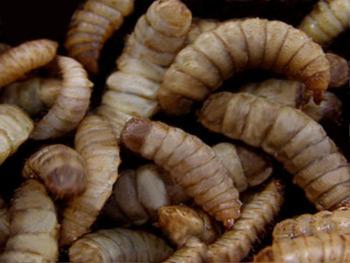Fattening maggots to create sustainable snack

Almost a billion people go to sleep hungry every night, according to Oxfam. Many people in the world don’t have sufficient land to grow food or income to purchase enough food.
Davia Allen wanted to create a sustainable human snack to address this growing problem. This 2016 Broadcom MASTERS finalist fattened fly larvae up on food wastes. She found that a cheap protein powder best pumped up the larvae.
Adult black soldier flies don’t eat, but their larvae eat organic wastes such as fruits and vegetables. Davia’s project focused on finding which diet could produce the biggest bugs.

Black solider fly larvae can be more than 40 percent protein by mass, which could make them a nutritious food for chickens, fish or people.
So she gave the larvae extra protein to see if they could grow even bigger. Three bins of larvae got produce that grocery stores deemed too ugly to sell. Three more bins got fruit and vegetables as well as soybeans finely ground to make a flour. Another three bins got the fruits and veggies and peanuts ground into flour. And a final three bins got fruits and veggies and flour made from a grain called quinoa. The flours were high in protein.
Read more about Davia’s maggot research in a Eureka! Lab blog post written by Bethany Brookshire.
Support future young scientists. Join the Society today!
After a month of feeding, weighing and cleaning, Davia compared the size of the larvae in each bin. Each bin started out with larvae that weighed around 7 grams (0.25 ounce). By the end, the larvae that only got fruits and vegetables grew to almost 35 grams (1.2 ounces). The larvae eating food enriched with soy flour grew the most — they weighed almost 55 grams (1.9 ounces). The quinoa-flour enriched bins averaged 51 grams (1.7 ounces) and the peanut flour group averaged 20 grams (0.7 ounce).
“Soy flour seems to hold the most promise for increasing larvae size while maintaining larvae health,” Davia said. It’s also the cheapest option. Ten grams (0.35 ounce) of soy flour only costs 6 cents. The same amount of peanut flour costs 15 cents and quinoa flour 12 cents.
Davia wants to boost awareness that black soldier fly larvae could covert food waste into something potentially snackable.


